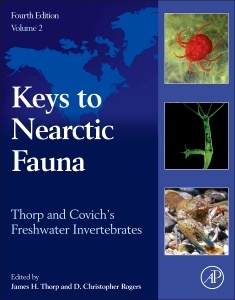Description
Thorp and Covich's Freshwater Invertebrates (4th Ed.)
Keys to Nearctic Fauna
Coordinators: Thorp James H., Rogers D. Christopher
Language: English
Subjects for Thorp and Covich's Freshwater Invertebrates:
Keywords
Amoebae; Amphids; Annelids; Annuli; Areoles; Arthropoda; Bdelloids; Bryozoan; Chaetae; Chaetonotida; Chrysophytes; Cilia; Ciliates; Cirrus; Clitellum; Cloacal opening; Cnidarians; Ectoprocta (Bryozoa)Floatoblasts; Entoprocta; Entoprocts; Eutardigrades; Flagellates; Freshwater; Furca; Gastrotricha; Gastrotrichs; Gordiids; Halacarid; Hibernaculum; Hydra; Invertebrates; Limnic; Mermithid; Metaniidae; Microscleres; Microturbellarians; Mites; Mollusca; Molluscs; Monogononts; Murrayidae; Nearctic; Nemata; Nematocysts; Nematodes; Nematomorpha; Nemertea; Nemerteans; Operculum; Phyla; Phylogenetic; Platyhelminthes; Polyps; Prostoma; Prostomium; Protozoa; Rotifera; Rotifers; Seisonids; Sessoblasts; Spicules; Spines; Spongillina; Statoblasts; Stylet; Tardigarda; Tardigrades; Taxa; Taxon; Taxonomy; Tectum; Tentacles; Tibia; Trophi; Turbellaria; Umbo; Urnatella; Zooids
762 p. · 21.5x27.6 cm · Hardback
Description
/li>Contents
/li>Biography
/li>Comment
/li>
Thorp and Covich's Freshwater Invertebrates: Keys to Nearctic Fauna, Fourth Edition presents a comprehensive revision and expansion of this trusted professional reference manual and educational textbook?from a single North American tome into a developing multivolume series covering inland water invertebrates of the world.
Readers familiar with the first three editions will welcome this new volume. The series, now entitled Thorp and Covich?s Freshwater Invertebrates, (edited by J.H. Thorp), began with Volume I: Ecology and General Biology, (edited by J.H. Thorp and D.C. Rogers).
It now continues in Volume II with taxonomic coverage of inland water invertebrates of the Nearctic zoogeographic region. As in previous editions, all volumes of the fourth edition are designed for multiple uses and levels of expertise by professionals in universities, government agencies, and private companies, as well as by undergraduate and graduate students.
Contributors to Volume II
About the Editors
Preface to the Fourth Edition
Preface to Volume II
Acknowledgments for Volume II
Chapter 1: Introduction
Chapter 2: Protozoa
Chapter 3: Phylum Porifera
Chapter 4: Phylum Cnidaria
Chapter 5: Phylum Platyhelminthes
Chapter 6: Phylum Nemertea
Chapter 7: Phylum Gastrotricha
Chapter 8: Phylum Rotifera
Chapter 9: Phylum Nemata
Chapter 10: Phylum Nematomorpha
Chapter 11: Phylum Mollusca
Chapter 12: Phylum Annelida
Chapter 13: Phylum Ectoprocta (Bryozoa)
Chapter 14: Phylum Entoprocta
Chapter 15: Phylum Tardigrada
Chapter 16: Phylum Arthropoda
Taxonomic Index
Dr. James H. Thorp is a professor and senior scientist at the University of Kansas (Lawrence, KS, United States). Prior to 2001, he was a distinguished professor and dean at Clarkson University, department chair and professor at the University of Louisville, associate professor and director of the Calder Ecology Center at Fordham University, and research ecologist at Georgia’s Savannah River Ecology Laboratory. He received his Baccalaureate from the University of Kansas and Masters and PhD degrees from North Carolina State. Prof. Thorp has been on the editorial board of three freshwater journals and is a former president of the International Society for River Science. His research interests run the gamut from organismal biology to community, ecosystem, and macrosystem ecology. While his research emphasizes aquatic invertebrates, he also studies fish ecology, especially food webs related. He has published more than 150 research articles and 10 books, including five volumes so far in the fourth edition of Thorp and Covich’s Freshwater Invertebrates.
Dr. D. Christopher Rogers is a research zoologist at the University of Kansas with the Kansas Biological Survey and is affiliated with the Biodiversity Institute. He received his Ph.D. degree from the University of New England in Armidale, NSW, Australia. Christopher specializes in freshwater crustaceans (particularly the Branchiopoda and the Decapoda) and the invertebrate fauna of seasonally astatic wetlands on a global scale. He has numerous peer reviewed publications in crustacean taxonomy and invertebrate ecology, as well as published popular and scientific field guides and identification manuals to freshwater invertebrates. Christopher is an Associate Editor for the Journal of Crustacean Biology and a founding member of the Southwest Association of Freshwater Invertebrate Taxonomists. He has been involved in aquatic invertebrate conservation efforts all over the world.
- Features zoogeographic coverage for all of North America, south to the general area of the Tropic of Cancer, and Greenland and Bermuda
- Provides keys to families of freshwater insects
- Provides keys to all other inland water invertebrates at the taxonomic level appropriate for the current scientific knowledge
- Includes multiple taxonomic keys in each chapter that progress from higher to lower taxonomic levels, thereby allowing users to work up to their level of need and expertise
- Presents additional material in each chapter on group introduction, limitations to the keys, terminology and morphology, material preparation and preservation, and references




